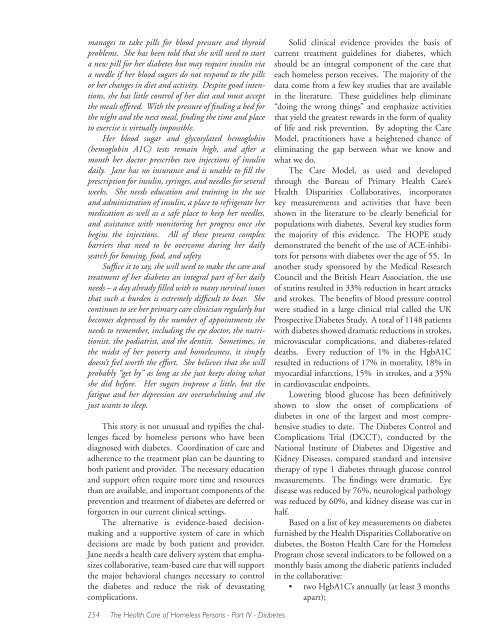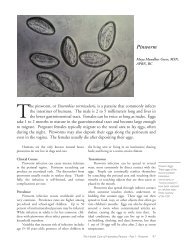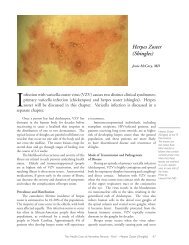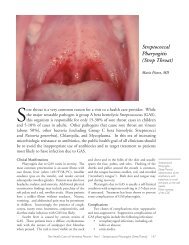Diabetes - Boston Health Care for the Homeless
Diabetes - Boston Health Care for the Homeless
Diabetes - Boston Health Care for the Homeless
Create successful ePaper yourself
Turn your PDF publications into a flip-book with our unique Google optimized e-Paper software.
manages to take pills <strong>for</strong> blood pressure and thyroidproblems. She has been told that she will need to starta new pill <strong>for</strong> her diabetes but may require insulin viaa needle if her blood sugars do not respond to <strong>the</strong> pillsor her changes in diet and activity. Despite good intentions,she has little control of her diet and must accept<strong>the</strong> meals offered. With <strong>the</strong> pressure of finding a bed <strong>for</strong><strong>the</strong> night and <strong>the</strong> next meal, finding <strong>the</strong> time and placeto exercise is virtually impossible.Her blood sugar and glycosylated hemoglobin(hemoglobin A1C) tests remain high, and after amonth her doctor prescribes two injections of insulindaily. Jane has no insurance and is unable to fill <strong>the</strong>prescription <strong>for</strong> insulin, syringes, and needles <strong>for</strong> severalweeks. She needs education and training in <strong>the</strong> useand administration of insulin, a place to refrigerate hermedication as well as a safe place to keep her needles,and assistance with monitoring her progress once shebegins <strong>the</strong> injections. All of <strong>the</strong>se present complexbarriers that need to be overcome during her dailysearch <strong>for</strong> housing, food, and safety.Suffice it to say, she will need to make <strong>the</strong> care andtreatment of her diabetes an integral part of her dailyneeds – a day already filled with so many survival issuesthat such a burden is extremely difficult to bear. Shecontinues to see her primary care clinician regularly butbecomes depressed by <strong>the</strong> number of appointments sheneeds to remember, including <strong>the</strong> eye doctor, <strong>the</strong> nutritionist,<strong>the</strong> podiatrist, and <strong>the</strong> dentist. Sometimes, in<strong>the</strong> midst of her poverty and homelessness, it simplydoesn’t feel worth <strong>the</strong> ef<strong>for</strong>t. She believes that she willprobably “get by” as long as she just keeps doing whatshe did be<strong>for</strong>e. Her sugars improve a little, but <strong>the</strong>fatigue and her depression are overwhelming and shejust wants to sleep.This story is not unusual and typifies <strong>the</strong> challengesfaced by homeless persons who have beendiagnosed with diabetes. Coordination of care andadherence to <strong>the</strong> treatment plan can be daunting toboth patient and provider. The necessary educationand support often require more time and resourcesthan are available, and important components of <strong>the</strong>prevention and treatment of diabetes are deferred or<strong>for</strong>gotten in our current clinical settings.The alternative is evidence-based decisionmakingand a supportive system of care in whichdecisions are made by both patient and provider.Jane needs a health care delivery system that emphasizescollaborative, team-based care that will support<strong>the</strong> major behavioral changes necessary to control<strong>the</strong> diabetes and reduce <strong>the</strong> risk of devastatingcomplications.Solid clinical evidence provides <strong>the</strong> basis ofcurrent treatment guidelines <strong>for</strong> diabetes, whichshould be an integral component of <strong>the</strong> care thateach homeless person receives. The majority of <strong>the</strong>data come from a few key studies that are availablein <strong>the</strong> literature. These guidelines help eliminate“doing <strong>the</strong> wrong things” and emphasize activitiesthat yield <strong>the</strong> greatest rewards in <strong>the</strong> <strong>for</strong>m of qualityof life and risk prevention. By adopting <strong>the</strong> <strong>Care</strong>Model, practitioners have a heightened chance ofeliminating <strong>the</strong> gap between what we know andwhat we do.The <strong>Care</strong> Model, as used and developedthrough <strong>the</strong> Bureau of Primary <strong>Health</strong> <strong>Care</strong>’s<strong>Health</strong> Disparities Collaboratives, incorporateskey measurements and activities that have beenshown in <strong>the</strong> literature to be clearly beneficial <strong>for</strong>populations with diabetes. Several key studies <strong>for</strong>m<strong>the</strong> majority of this evidence. The HOPE studydemonstrated <strong>the</strong> benefit of <strong>the</strong> use of ACE-inhibitors<strong>for</strong> persons with diabetes over <strong>the</strong> age of 55. Inano<strong>the</strong>r study sponsored by <strong>the</strong> Medical ResearchCouncil and <strong>the</strong> British Heart Association, <strong>the</strong> useof statins resulted in 33% reduction in heart attacksand strokes. The benefits of blood pressure controlwere studied in a large clinical trial called <strong>the</strong> UKProspective <strong>Diabetes</strong> Study. A total of 1148 patientswith diabetes showed dramatic reductions in strokes,microvascular complications, and diabetes-relateddeaths. Every reduction of 1% in <strong>the</strong> HgbA1Cresulted in reductions of 17% in mortality, 18% inmyocardial infarctions, 15% in strokes, and a 35%in cardiovascular endpoints.Lowering blood glucose has been definitivelyshown to slow <strong>the</strong> onset of complications ofdiabetes in one of <strong>the</strong> largest and most comprehensivestudies to date. The <strong>Diabetes</strong> Control andComplications Trial (DCCT), conducted by <strong>the</strong>National Institute of <strong>Diabetes</strong> and Digestive andKidney Diseases, compared standard and intensive<strong>the</strong>rapy of type 1 diabetes through glucose controlmeasurements. The findings were dramatic. Eyedisease was reduced by 76%, neurological pathologywas reduced by 60%, and kidney disease was cut inhalf.Based on a list of key measurements on diabetesfurnished by <strong>the</strong> <strong>Health</strong> Disparities Collaborative ondiabetes, <strong>the</strong> <strong>Boston</strong> <strong>Health</strong> <strong>Care</strong> <strong>for</strong> <strong>the</strong> <strong>Homeless</strong>Program chose several indicators to be followed on amonthly basis among <strong>the</strong> diabetic patients includedin <strong>the</strong> collaborative:• two HgbA1C’s annually (at least 3 monthsapart);254 The <strong>Health</strong> <strong>Care</strong> of <strong>Homeless</strong> Persons - Part IV - <strong>Diabetes</strong>







